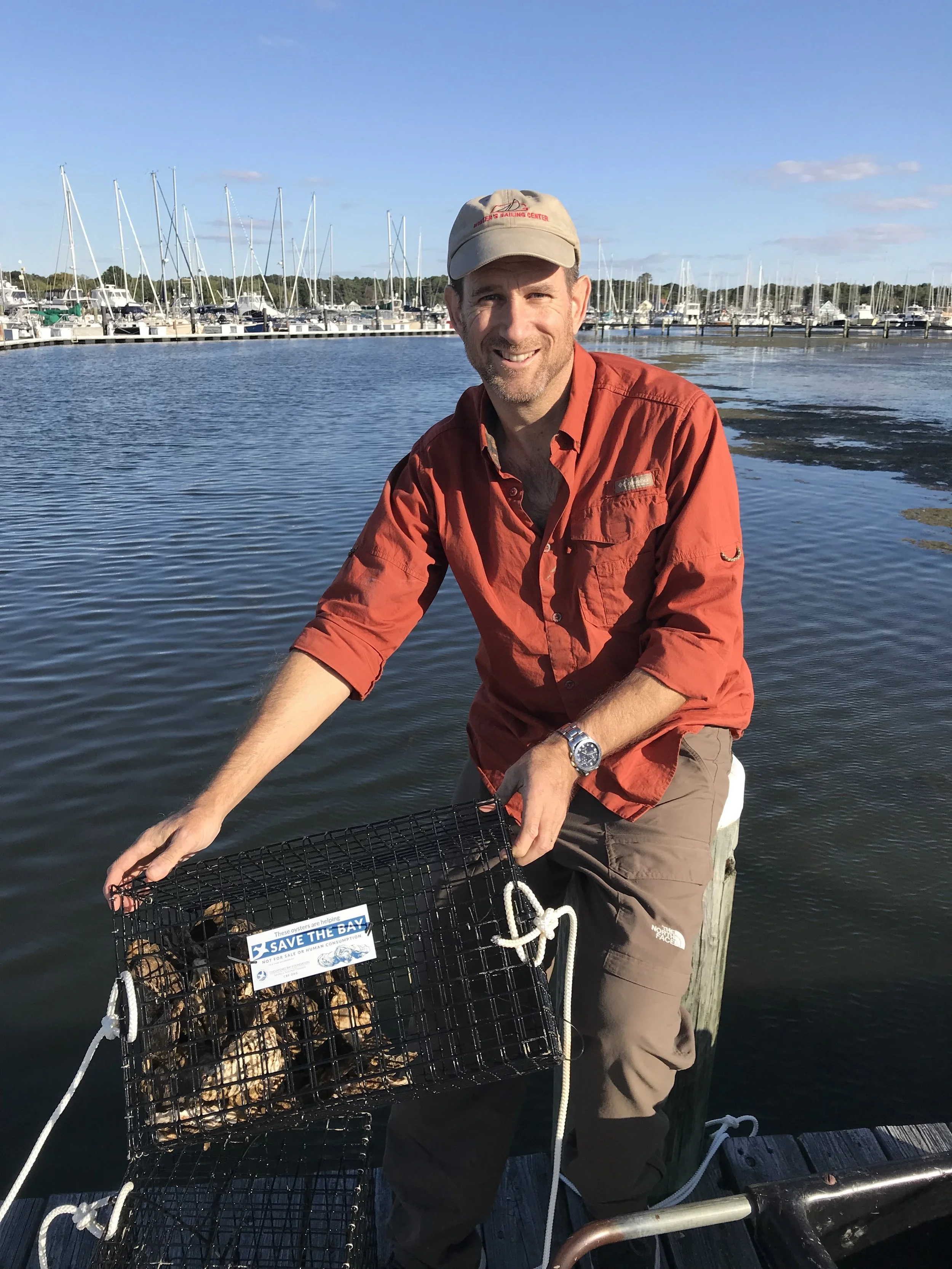Shardana Starts an Oyster Nursery. How Many Oysters are on Your Half-Shell?
By Captain Davis Jones
Captain Davis Jones getting ready to place Oysters in the water off our dock.
Last time I got oysters on the half-shell, there was just one slimy little critter for every shell. But the Chesapeake Bay Foundation (CBF)does a lot better than that! Every shell they gave me had 4 – 8 baby oysters affixed, ready to grow. Sounds like a good deal, but they’re not for eating. Instead, they are meant to help improve the water quality and restore an ancient ecosystem in the Chesapeake Bay.
Each Baby OYster is Called “SPAT”
They are circled in red. They look like barnacles on a rock at this stage. While they will adhere and grow on rocks or concrete, they like shells even better.
With permission from the management at Osprey Point Marina, I signed up with CBF to become a foster parent of a few hundred baby oysters (I neither counted nor named them). After a brief training, Patrick Beall, CBF’s Oyster Restoration Specialist, taught us the history and biology of oysters in the Chesapeake and I learned how critical they are to the health of the Bay. For you to know, each adult oyster will filter up to 50 gallons of water a day, using the nutrients to grow and excreting the sediments and nitrogen into a “biodeposit” (fancy word for oyster poop) that helps stabilize the reef and remove contaminants from the water column.
Pat asked all the boaters in the crowd if we had ever run aground in the Bay. There were no liars in the room, and we all admitted our faults. He then asked if we had ever run aground on an oyster reef, and all hands went down. Apparently, when Captain John Smith first explored the Bay in 1608, he continually ran into oyster reefs, and he knew that because he could see the bottom! Let’s see, lots of oysters and clear water – is there a correlation?
Overfishing and poor fishery management coupled with the introduced diseases Dermo and MSX, have decimated the oyster population of the Bay over the past 100 years, and it is our responsibility to help them come back. Not only do they clean the water, but their vertical growth patterns create reefs that help slow the water flow allowing more sediments to settle out and providing shelter for fish and other marine life critical to the health of the Bay. Plus, they’re dang good eating once you get past the gross factor. (Get them fried or Rockefeller if you can’t stomach slurping them raw.)
During the class, Pat explained our role in CBF’s Oyster Restoration Program and what else they and others are doing to bring back the oysters, in both commercial fisheries and in sanctuaries all over the Bay. Despite my environmental science degree, I knew nothing about the natural and enhanced life cycle of our oysters and their critical role in the ecosystem and economy. I learned a lot.
Then we got to work. First, we had to build our cages and pick up our “spat on shell.” The embryos were raised at the Horn Point Oyster Hatchery in Cambridge, MD, then planted onto recycled, cleaned shells (baby oysters don’t like cocktail sauce) at CBF’s Oyster Restoration Facility in Shadyside, MD.
Nothing is easy with one working leg – I broke my knee skiing in Chile when I should have been sailing here. So I enlisted my sister, Kathy, to help out. What better way to spend your birthday than mucking around with muddy oyster spat?
Kathy helped carry everything while I tied the cages together and we set the spat out on the fixed docks at Osprey Point so they can grow over the winter in protected waters with a little loving care from their foster parents. (Capt. Andrew was supposed to help, but he was a little late to the party – enjoying the breeze on Shardana…Slacker!)
S/V Shardana
Preparing to Dock
We were finally ready to let them go and will be back every few weeks to clean them up and make sure the crabs haven’t gotten into the cages for their own oyster feast.
That evening, we capped off our service with a nice birthday dinner at Pearl on Main. Don’t worry, while these were small, flavorful local oysters, nobody gets to eat my babies. After a season growing in peace, they’ll go to a nice, protected sanctuary to live out their lives in peace. Come out for a charter next spring (our 2020 schedule has been posted) and you can help, too.













